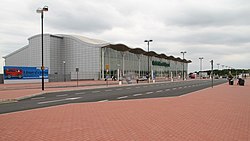Robin Hood Airport
| Doncaster Sheffield Airport | |||||||||||
|---|---|---|---|---|---|---|---|---|---|---|---|
 |
|||||||||||
| Summary | |||||||||||
| Airport type | Public | ||||||||||
| Owner | Peel Group | ||||||||||
| Operator | Doncaster Sheffield Airport Limited | ||||||||||
| Serves | Doncaster, Sheffield | ||||||||||
| Location | Finningley, South Yorkshire | ||||||||||
| Opened | April 2005 | ||||||||||
| Elevation AMSL | 56 ft / 17 m | ||||||||||
| Coordinates | 53°28′31″N 001°00′15″W / 53.47528°N 1.00417°WCoordinates: 53°28′31″N 001°00′15″W / 53.47528°N 1.00417°W | ||||||||||
| Website |
flydsa.co.uk dsaflights.co.uk |
||||||||||
| Map | |||||||||||
| Location in South Yorkshire | |||||||||||
| Runways | |||||||||||
|
|||||||||||
| Statistics (2016) | |||||||||||
|
|||||||||||
| Passengers | 1,255,907 |
|---|---|
| Passenger change (15-16) |
|
| Aircraft Movements | 16,098 |
| Movements change (15-16) |
|
Doncaster Sheffield Airport (IATA: DSA, ICAO: EGCN), formerly named Robin Hood Airport Doncaster Sheffield, is an international airport located at the former RAF Finningley station at Finningley, in the Metropolitan Borough of Doncaster within South Yorkshire, England. The airport lies 3 miles (5 kilometres) southeast of Doncaster and 18 mi (29 km) east of Sheffield. Handling 1.26 million passengers in 2016, the airport is the smaller of Yorkshire's two large commercial airports, the other being Leeds Bradford Airport.
The airport opened to passengers in 2005. It was initially operated by Peel Airports, a division of The Peel Group, who at the time also owned and managed Liverpool John Lennon Airport and City Airport Manchester, and had a 75% stake in Durham Tees Valley Airport. Doncaster Sheffield Airport has a CAA Public Use Aerodrome Licence (Number P876) that allows flights for the public transport of passengers or for flying instruction.
The airport owes its origins to military aviation, having been founded as Finningley Airfield in 1915.
During the First World War, it was used as a base by the Royal Flying Corps as they intercepted German Zeppelins targeting the industrial cities of the North. In the Second World War the airfield was used primarily for training purposes, serving as a finishing school for new crews of the larger aircraft in Bomber Command; only a few combat missions took off from Finningley. The Cold War saw the airfield's importance rise when it was used for nuclear-armed Vulcan bombers. Training once again became the priority in the 1970s and 1980s before the airport was decommissioned in 1995.
...
Wikipedia

